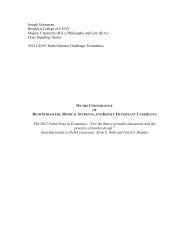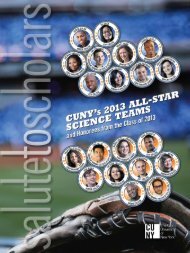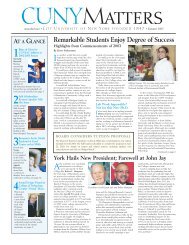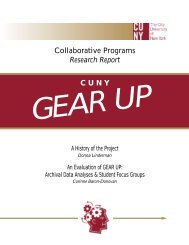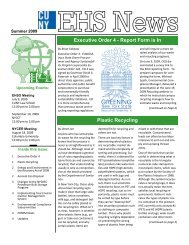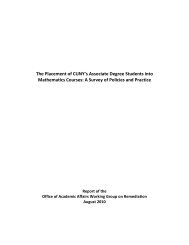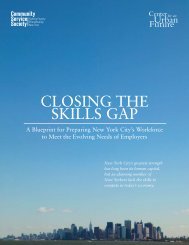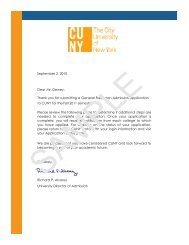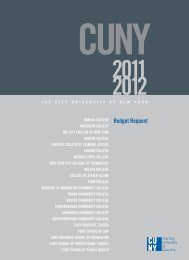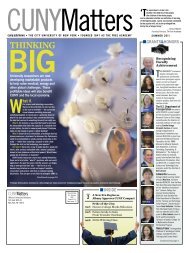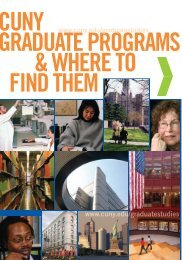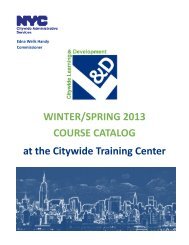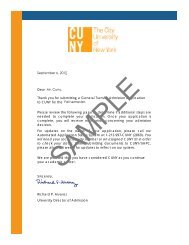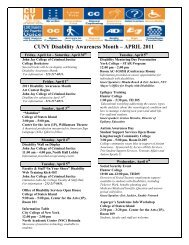CUNY Master Plan 2012-2016
CUNY Master Plan 2012-2016
CUNY Master Plan 2012-2016
You also want an ePaper? Increase the reach of your titles
YUMPU automatically turns print PDFs into web optimized ePapers that Google loves.
THE <strong>CUNY</strong> MASTER PLAN <strong>2012</strong>-<strong>2016</strong><br />
<strong>CUNY</strong>, a broad program composed of three key pillars: the <strong>CUNY</strong> Sustainability Project, citywide Sustainable<br />
Energy projects, and <strong>CUNY</strong> SustainableWorks.<br />
<strong>CUNY</strong> Sustainability Project<br />
In June 2007, Chancellor Goldstein accepted Mayor Bloomberg’s PlaNYC “30 in 10” University<br />
Challenge to reduce carbon emissions on its campuses by 30 percent by 2017. The <strong>CUNY</strong> Sustainability<br />
Project was established to respond to this challenge and a core team formed to help each campus<br />
create a 10-year sustainability plan. As part of this project, <strong>CUNY</strong> colleges also responded to New<br />
York State Executive Order Number 4 calling for state agencies to green their procurement management,<br />
enhance recycling and waste management, and develop a sustainability plan. This project seeks<br />
to integrate sustainable practices into <strong>CUNY</strong>’s operations, curriculum, and research and by partnering<br />
with civic and business leaders, to establish <strong>CUNY</strong> as a leader in areas that fall under the rubric of<br />
sustainability.<br />
The campus plans identified over 800 actions to implement by 2017. At the end of 2011, <strong>CUNY</strong> had<br />
already reduced its emissions by 19 percent, more than halfway to its goal of 30 percent. PlaNYC, through<br />
the Department of Citywide Administrative Services (DCAS), reserved $30 million dollars for <strong>CUNY</strong><br />
infrastructure projects, with a $30 million dollar match from New York State, to be distributed by 2017.<br />
As of December 2011, $19,293,000 had been allocated for projects, including funds for energy audits at the<br />
community colleges.<br />
Many degree programs now include sustainability components, and more than 100 continuing education<br />
classes cover various sustainability topics. Through the Green Energy Training program at the Center<br />
for Sustainable Energy at Bronx Community College, hundreds of students have been trained in solar<br />
system design and installation, home energy auditing, and geothermal technologies. Solar teaching labs<br />
at Bronx and LaGuardia Community Colleges and Medgar Evers College will ensure that <strong>CUNY</strong> can meet<br />
the demand for green jobs and that clean technology is being piloted at the campuses.<br />
Looking toward 2017, all new <strong>CUNY</strong> construction projects will continue to seek LEED Silver certification<br />
or higher. The rooftops of most of <strong>CUNY</strong>’s buildings have been assessed for their potential to host<br />
solar power, with a dozen put forward as potential sites. Further, two large solar installations at LaGuardia<br />
and Borough of Manhattan Community Colleges, when completed, will further increase the use of renewable<br />
energy at <strong>CUNY</strong>. By 2013, all campuses will have had a full energy audit, providing the colleges with<br />
the documentation needed to secure additional funding for projects that will reduce emissions.<br />
Sustainable Energy<br />
In 2007, Sustainable <strong>CUNY</strong> was named the lead of the U.S. Department of Energy Solar America City<br />
Partnership for New York City. Partnering with the NYC Economic Development Corporation, the<br />
Mayor’s Office of Long-Term <strong>Plan</strong>ning and Sustainability, Con Edison, and others, Sustainable <strong>CUNY</strong> is<br />
working to strengthen and enable the solar market by addressing the barriers to using solar energy, and<br />
expanding workforce and economic development initiatives.<br />
86



